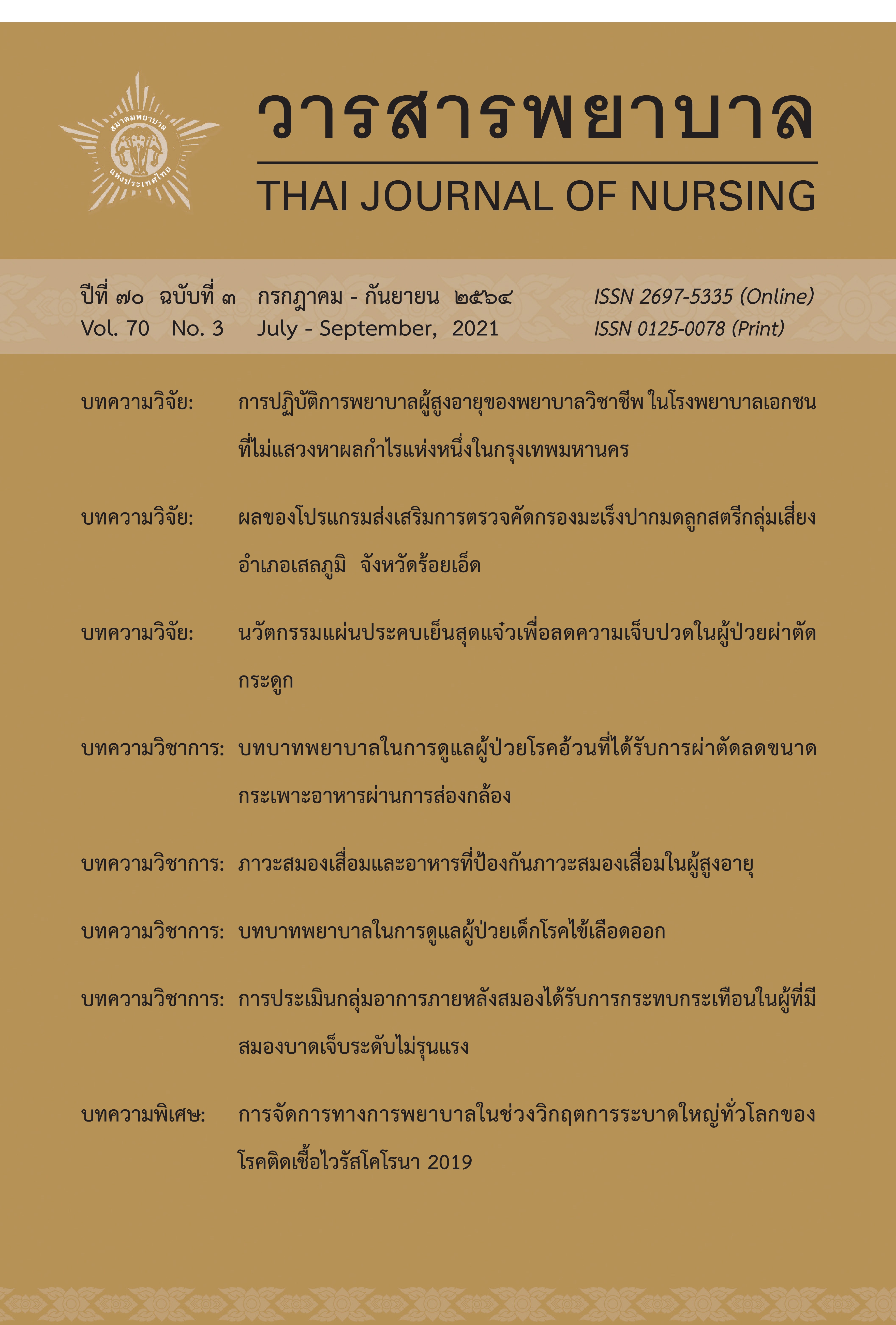An innovative “ Wonder Cold Pad for pain relief ” in patients with orthopedic surgery
Main Article Content
Abstract
This research and development aimed to develop an innovative cold pad to reduce pain in patients after orthopedic operation by modifying a traditional cold pad into this new one with the property of instant cooling system and evaluate its effectiveness. The sample of 9 patients with orthopedic surgery in one hospital, was purposively selected for trial use within 1 month. The research tool was a questionnaire on patient satisfaction developed by researchers and was validated by 3 experts. Data analysis were done using descriptive statistics. The result revealed that the patients felt satisfied on the developed cold pad at the highest level (M =3.74, SD = 0.39). The addition, they expressed more opinions that this cold pad can reduce wound pain due to its constant cooling.
Article Details
References
ปวดในผู้ป่วยออร์โธปิดิกส์: ถอดบทเรียนภาควิชาออร์โธปิดิกส์ มหาวิทยาลัยเชียงใหม่.
สืบค้นเมื่อ 10 สิงหาคม 2563, จาก https://w2.med.cกu.ac.th/northo/index.php?
option=com_content&view=article&id=39:painmanagement&catid=
9&Itemid=219
โรงพยาบาลสมุทรสาคร. (2562). รายงานประจำปี 2562 หอผู้ป่วยศัลยกรรมกระดูกชาย.
สมุทรสาคร: ผุ้แต่ง.
วรรณี สัตยวิวัฒน์. (2551). การพยาบาลผู้ป่วยออร์โธปิดิกส์ (พิมพ์ครั้งที่ 6). กรุงเทพมหานคร: เอ็น
พี เพรส.
สดากาญจน์ เอี่ยมจันทร์ประทีป, และธวัชชัย ทีปะปาล. (2560). ผลของการประคบเย็นร่วมกับการ
ส่งเสริมสมรรถนะแห่งตนต่อความปวดและการฟื้นฟูสภาพ หลังผ่าตัดใส่เหล็กดามกระดูกต้น
ขา. พยาบาลสาร, 44(1), 39-49.
Bleakley, C., Mc Donough, S., Gardner, E., Baxter, G. D., Hopkins. J. T., & Davison. G.
W. (2012). Cold-water immersion (cryotherapy) for preventing and treating
muscle soreness after exercise. Cochrane Database of Systematic Reviews,
(2), CD008262. doi: 10.1002/14651858.CD008262.pub2
Birnie, K. A., Parker, J. A., & Chambers, C.T. (2016). Relevance of water
temperature, apparatus, and age to children’s pain during the cold pressor
task. Pain Practice, 16(1), 46-56. doi: 10.1111/papr.12257
Chou, R., Huffman, L. H., American Pain Society, & American College of Physicians.
(2007). Nonpharmacologic therapies for acute and chronic low back pain: A
review of the evidence for an American Pain Society/American College o
Physicians clinical practice guideline. Annals of Internal Medicine, 147(7),
492-504.
Jon, E. B. (2010). Cold and compression in the management of musculoskeletal
injuries and orthopedic operative procedures: A narrative review. Journal of
Sport Medicine, 1, 105-113.
Malanga, G. A., Yan, N., & Stark, J. (2015). Mechanisms and efficacy of heat and cold
therapies for musculoskeletal injury. Postgraduate Medicine, 127(1), 57–65.
Melzack, R., & Katz, J. (2004). The Gate Control Theory: Reaching for the brain. In
T. Hadjistavropoulos & K. D. Craig (Eds.). Pain: Psychological perspectives
(pp. 13–34). Mahwah, NJ: Lawrence Erlbaum Associates.


